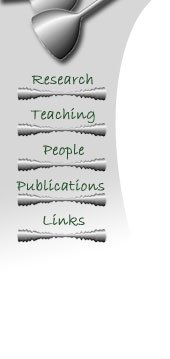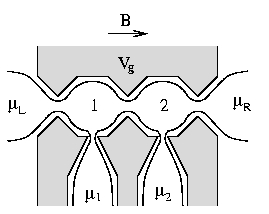

Quantum Dots
- Coherence and Decoherence in Tunneling between Quantum Dots , with D. M. Cardamone and B. R. Barrett. Coupled quantum dots are an example of the ubiquitous quantum double potential well. In a typical transport experiment, each quantum dot is also coupled to a continuum of states. Our approach takes this into account by using a Green's function formalism to solve the full system. The time-dependant solution is then explored in different limiting cases. In general, a combination of coherent and incoherent behavior is observed. In the case that the coupling of each dot to the macroscopic world is equal, however, the time evolution is purely coherent.
- Aharanov-Bohm/Casher Effect in a Kondo Ring , with H.-P. Eckle and H. Johannesson. The influence of a magnetic impurity or ultrasmall quantum dot on the spin and charge persistent currents of a mesoscopic ring is investigated. The system consists of electrons in a one-dimensional ring threaded by spin--dependent Aharonov-Bohm/Casher fluxes, and coupled via an antiferromagnetic exchange interaction to a localized electron. The problem is mapped onto a Kondo model for the even-parity channel plus free electrons in the odd-parity channel. The twisted boundary conditions representing the fluxes couple states of opposite parity unless the independent twist angles for up and down spins correspond to periodic or antiperiodic boundary conditions. For these special values of the fluxes, the model is solved by the Bethe ansatz.
- Correlated charge polarization of coupled quantum dots , with R. Kotlyar and S. Das Sarma. Coherent charge transfer in a linear array of tunnel-coupled quantum dots, electrostatically coupled to external gates, is investigated using the Bethe ansatz for a symmetrically biased Hubbard chain. Charge polarization in this correlated system is shown to proceed by two distinct processes: formation of bound states in the metallic phase, and charge transfer processes corresponding to a superposition of antibound states at opposite ends of the chain in the Mott-insulating phase. The polarizability in the insulating phase of the system exhibits a universal scaling form, while the polarization charge in the metallic phase is shown to be quantized in units of e /2.
- Coherent Magnetotransport Through an Artificial Molecule , with Sankar Das Sarma. Coherent resonant tunneling through a double quantum dot in an inhomogeneous magnetic field is investigated using a generalized Hubbard model. The conductance is calculated analytically for the case of a single spin-1/2 orbital per dot and numerically for dots containing multiple orbitals, including inelastic processes explicitly. Giant spin-dependent many-body corrections to the transport are predicted to be a clear signature of the formation of a molecular-like state in the system.
- Nonlinear Conductance in Resonant Tunneling . A multi-terminal conductance formula describing resonant tunneling through an interacting mesoscopic system is derived and used to investigate the nonlinear conductance of a quantum dot. An explicit gauge-invariant expression for the I - V characteristic which depends sensitively on the full capacitance matrix is obtained. A voltage probe is found to have a dramatic effect on the nonlinear conductance.
- Quantum transport through a time-dependent two-level system , with Ned Wingreen. The time average of the fully nonlinear current through a double quantum dot, subject to an arbitrary combination of ac and dc voltages, is calculated exactly using the Keldysh nonequilibrium Green function technique. Important corrections to sequential tunneling are predicted to occur when the Rabi frequency of interdot oscillations becomes comparable to the tunneling rate of electrons into the system. For reverse bias, the system functions as an efficient electron pump when driven on resonance due to Rabi oscillations between the dots. For forward bias, the system can operate as a low-threshold current-injection laser. It is shown that the Rabi splitting can be resolved by examining the I - V characteristic of the electron pump, and it is predicted that the interdot Rabi oscillations can be time-resolved by applying microwave pulses of varying lengths.
- Charge-transfer induced persistent current and capacitance oscillations , with Markus Büttiker. The polarizability of a phase-coherent mesoscopic system capacitively coupled to external voltage sources is investigated. In small-capacitance structures, where Coulomb charging effects are dominant, the polarizability is found to exhibit sharp charge transfer resonances. Charge transfer from a side branch quantum dot into a ring changes the persistent current through a sequence of plateaus of diamagnetic and paramagnetic states. In contrast, a quantum dot embedded in a ring exhibits resonances in the persistent current, whose sign is independent of the number of electrons in the dot if the total number of electrons in the system is even. It is shown that such a mesoscopic system can be polarized appreciably not only by the application of an external voltage, but also via an Aharonov-Bohm flux.
- Theory of collective Coulomb blockade in an array of quantum dots , with Sankar Das Sarma. The conductance, capacitance, and infrared absorption in an extended multiband Hubbard model describing linear arrays of two to twelve quantum dots is calculated via a Lanczos technique. The interplay of quantum confinement, interdot tunneling, and strong intradot Coulomb interactions leads to a sequence of two quantum phase transitions (spin polarization transition in a magnetic field and Mott-Hubbard metal-insulator transition) separating a region of collective Coulomb blockade from a region where the Coulomb blockade of the individual dots is maintained, and a region where the Coulomb blockade is destroyed altogether. These two transitions are predicted to have dramatic experimental signatures even in relatively small clusters of coupled quantum dots.
Publications
- C. A. Stafford and S. Das Sarma,
Collective Coulomb Blockade in an Array of Quantum Dots: A Mott-Hubbard Approach ,
Phys. Rev. Lett. 72 , 3590 (1994).
- C. A. Stafford and S. Das Sarma,
Transport and Optical Spectroscopy of an Array of Quantum Dots with Strong Coulomb Correlations ,
in ``Quantum Transport in Ultrasmall Devices,'' D. K. Ferry, H. L. Grubin, C. Jacoboni, and Antti-Pekka Jauho eds.
(Plenum, New York, 1995), p. 445.
- M. Büttiker and C. A. Stafford,
Charge Transfer Induced Persistent Current and Capacitance Oscillations ,
Phys. Rev. Lett. 76 , 495 (1996).
- C. A. Stafford and Ned S. Wingreen,
Resonant Photon-Assisted Tunneling Through a Double Quantum Dot:
An Electron Pump From Spatial Rabi Oscillations ,
Phys. Rev. Lett. 76 , 1916 (1996).
- C. A. Stafford,
Nonlinear Conductance in Resonant Tunneling ,
Phys. Rev. Lett. 77 , 2770 (1996).
- M. Büttiker and C. A. Stafford,
Coherent Charge Transfer Resonances and Fluctuations in a Mesoscopic Ring Coupled to a Quantum Dot ,
in ``Correlated Fermions and Transport in Mesoscopic Systems,'' T. Martin, G. Montambaux, and J. Tran Thanh Van eds.
(Editions Frontieres, Gif-sur-Yvette, 1996), p. 491.
- C. A. Stafford and S. Das Sarma,
Coherent Magnetotransport Through an Artificial Molecule ,
Phys. Lett. A 230 , 73 (1997).
- Ned S. Wingreen and C. A. Stafford,
Quantum-Dot Cascade Laser: Proposal for an Ultra-Low-Threshold Semiconductor Laser ,
IEEE J. Quantum Electron. 33 , 1170 (1997).
- R. Kotlyar, C. A. Stafford, and S. Das Sarma,
Correlated charge polarization in a chain of coupled quantum dots ,
Phys. Rev. B 58 , R1746 (1998).
- R. Kotlyar, C. A. Stafford, and S. Das Sarma,
Addition spectrum, persistent current, and spin polarization in coupled quantum-dot arrays:
Coherence, correlation, and disorder ,
Phys. Rev. B 58 , 3989 (1998).
- C. A. Stafford, R. Kotlyar, and S. Das Sarma,
Coherent resonant tunneling through an artificial molecule ,
Phys. Rev. B 58 , 7091 (1998).
- H.-P. Eckle, H. Johannesson, and C. A. Stafford,
Aharonov-Bohm/Casher Effect in a Kondo Ring ,
Physica B 284 , 1872 (2000).
- H.-P. Eckle, H. Johannesson, and C. A. Stafford,
Kondo Impurity in a Mesoscopic Ring: Charge Persistent Current ,
J. Low Temp. Phys. 118 , 475 (2000).
- H.-P. Eckle, H. Johannesson, and C. A. Stafford,
Persistent Currents in a Kondo Ring ,
in ``Quantum Physics at the Mesoscopic Scale,'' D. C. Glattli, M. Sanquer, and J. Tran Thanh Van eds.
(EDP Sciences, Les Ulis, France, 2000), pp. 445-449.
- H.-P. Eckle, H. Johannesson, and C. A. Stafford,
Kondo Resonance in a Mesoscopic Ring Coupled to a Quantum Dot: Exact Results for the Aharonov-Bohm/Casher Effects ,
Phys. Rev. Lett. 87 , 16602 (2001).
- D. M. Cardamone, C. A. Stafford, and B. R. Barrett,
Coherence and Decoherence in Tunneling between Quantum Dots ,
Phys. Stat. Sol. (b) 230 , 419-423 (2002).
